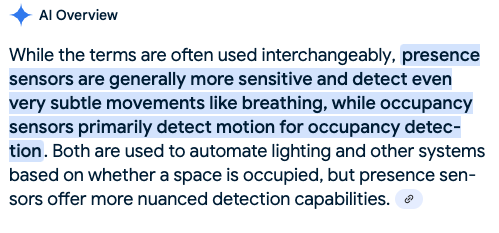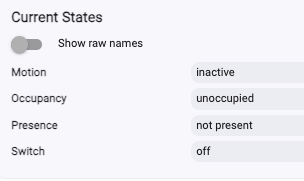I would like to propose adding a new capability "Occupancy" that would be used especially with all the new mmWave sensors and others of course like BLE beacons and others. This would finally help in distinguishing between presence, motion when we are dealing with this new technology.
Excellent idea - moving it to Feedback
+1
Beat me to it. ![]()
- another...
Big +1
@kkossev yes and it's 1 1/2 years later and still not added, this new tech is moving fast and will most likely become main stream real fast!
I'll do Devil's Advocate: ![]()
![]()
If we can live with motor speed being controlled by setLevel, where the driver converts 0-100 to discreet speeds, then we can live with the interchangeability of "Presence" vs "Occupancy"
In fact, I'd assume that it would be coded as an Alias internally.
There's a real world difference but I'm pretty sure the words have changed meaning over the past decade. I have an "occupancy switch" in my Laundry room. The instructions offer several modes where it can turn the light on and then off OR only turn the light off. The latter is called 'occupancy' by them... motion does not turn the light on, but if it is on, when there's no motion, it will turn the light off after some delay. I use it in "presence" mode, where the light is both turned on and then off by motion, or lack.
The result is the words have context dependent meanings or in the wilder world, "occupancy" is the lower sensitivity version of the idea. Yet the OP wants it for MM Wave devices, which are the higher sensitivity version of the idea.

The problem I see is NOT the invention of a new capability, but in how the resulting attribute gets used. If you have a room with both a traditional PIR motion sensor AND a mmWave sensor, then the use, in an automation, would be WHAT? I have this situation in 3 of my rooms, so I know what I want, and since I have (today) only the choice of "motion" am I unable/confused to create an automation? No. ![]()
They'd both be binary attributes: true or false, expressed as the corresponding word(s): active, inactive, occupied, not occupied, which further emphasizes the lack of a distinction. ![]()
Here's a Driver that supports "Occupancy", "Presence", "Motion" and "Switch":

If this would be a very rare case of a capability, sure just add it in the driver as you like, it does not need to be supported from HE to be able to declare it and use it.
BUT having it officially supported from HE makes it a capability that all drivers and apps would eventually use, those sensors that have both occupancy and motion would be a lot more useful and clear of what they are reporting for everyone including new users.
As to the interchangeability of the words, sure in the english language they could be interchanged, but in the automation world (at least to me), occupancy seems more like the room is occupied or not vs the house has a presence or not (nothing to do with ghosts). I believe it's just a better way of separating both of them and making them more specific.
Just my 2C and it will be HE's decision in the long run, but I think that the faster it's implemented/added, the faster it will be adopted by the drivers/apps that we develop.
My Devil's Advocate position is that it adds confusion, not reducing it.
The Zwave and Zigbee specs don't make the distinction as far as I remember, meaning that product manufacturers must choose to send either motion or presence. "Occupancy" isn't available to them, although it's been a while since I read the specs.
Totally understand your point!
To me, motion and occupancy are way different things. Presence vs occupancy blurs a bit, but I think there is a distinction.
- Motion would be people actively moving about a space. I think that is fairly straightforward.
- Occupancy would be someone is in a particular area, but not necessarily moving about. You are lounging on the sofa to watch a movie. Or you manually set this to state to keep lights on while you are sitting to read at the dining room table. It also could be sensed from motion.
- Presence would be someone is home, but not necessarily in the area that is being watched by an occupancy or motion sensor. To me, it is derived from something like a fob, phone, or similar detecting you are within range of the home. Maybe you are home, but in the yard, and don't want to lock the house (automatically) and stop your automations.
Here is a nice distinction made from Google AI
EDIT: When I first did this search of "Occupancy vs presence vs motion", the AI response gave a description of presence as being the presence of a device like a phone or other physical device that reports that it's inside a geofenced area or within reach of another device. Now that a reread what I pasted below, even I'm as confused as the Google's AI ![]()
![]()
AI Overview
In the context of smart home or building automation, "motion," "presence," and "occupancy" describe different levels of detecting human presence and activity. Motion refers to detecting movement, presence detects even subtle movements or body heat, and occupancy often implies the overall state of being in a space, which can be triggered by motion or presence detection and may persist for a time even after movement stops.
Here's a more detailed breakdown:
- Motion Sensors:
- Detects: Movement of objects, often within a specific range and sensitivity.
- Typically used for: Triggering actions based on movement, like turning on lights or triggering an alarm.
- Limitations: Can be triggered by pets, objects, or fail to detect someone who is still.
- Presence Sensors:
- Detects:
Subtle human presence, including small movements like breathing or body heat.
- Typically used for:
More accurate detection of occupancy in spaces where people might be still (e.g., reading, working at a desk), and can be used for controlling lighting, temperature, or other systems.
- May use:
Technologies like PIR (Passive Infrared), ultrasonic, or radar/microwave sensors.
- Occupancy Sensors:
- Concept:
Encompasses the overall state of being in a space, which can be triggered by motion or presence sensors.
- Functionality:
May combine motion and/or presence detection with a timer or other logic to determine occupancy and control systems.
- Example:
A light might turn on when motion is detected (motion sensor) and stay on for a set period after the last motion (occupancy logic).
- Often used for:
Controlling lighting, HVAC, and other systems based on whether a space is occupied or not, even if the occupants are not actively moving.
In essence:
- Motion sensors are basic movement detectors.
- Presence sensors are more sensitive and can detect subtle movements or body heat.
- Occupancy sensors combine motion and/or presence detection with logic to determine if a space is occupied, and may persist after the initial trigger.
Just to add to the fun and confusion, we have Hubitat's (thanks to its SmartThings heritage) use of "Presence" to indicate geofence-based user location. Whereas many mmWave sensor manufactures have chosen to call their devices "Presence Sensors" instead of "Motion Sensors."
I wonder if the Matter specification calls these out separately or not? If so, I wonder what that team's thinking was?

